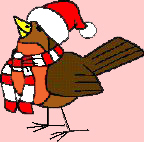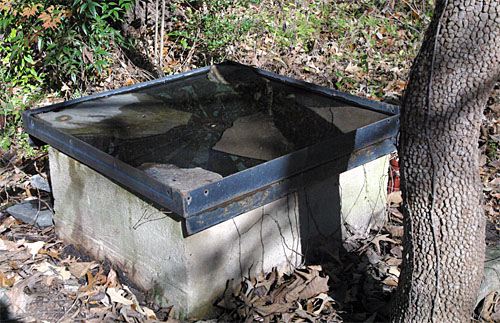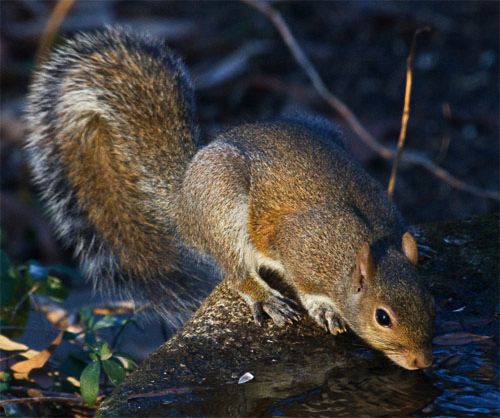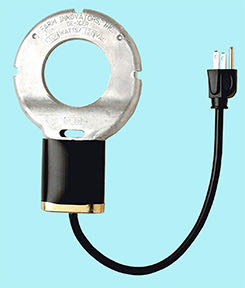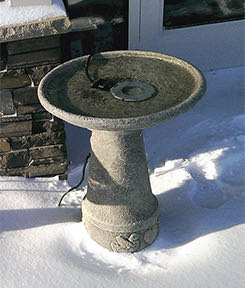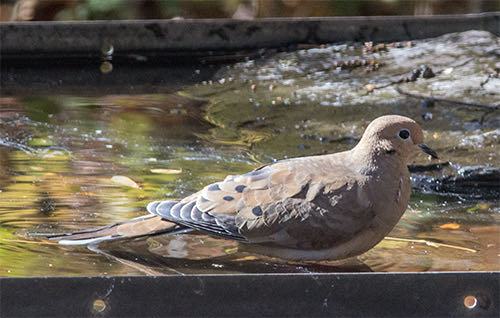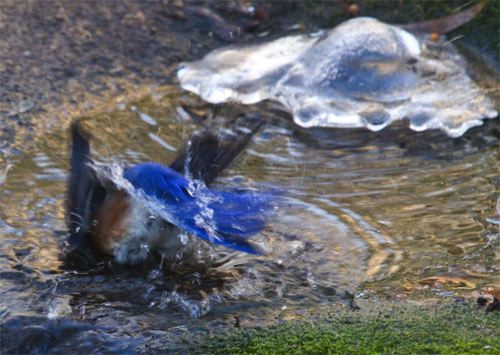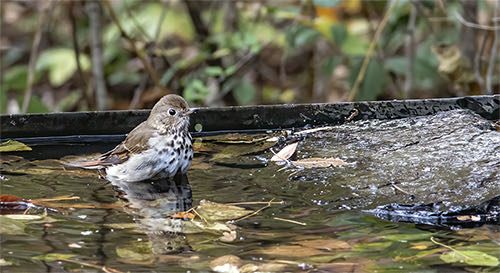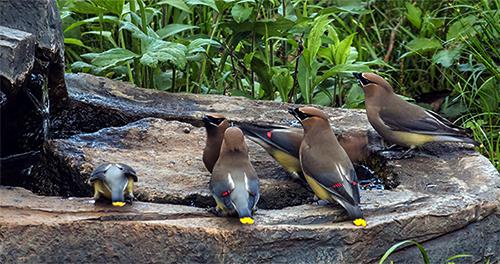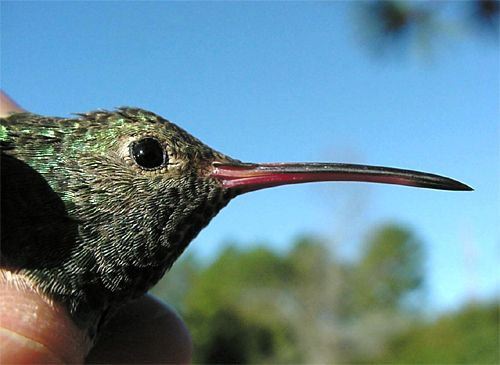- Established 1982 -HOME: www.hiltonpond.org
THIS WEEK at HILTON POND Subscribe for free to our award-winning nature newsletter (Back to Preceding Week; on to Next Week) |
Join Us for the |
|
| KEEPING THINGS WARM FOR WINTER BIRDS As November 2019 progressed, Hilton Pond Center experienced a wide range of temperatures, from a very frigid 17.3°F on the 13th to a balmy 67.1°F on the 30th. Precipitation was nearly lacking for the last half of the month--only 0.8" in our digital rain gauge from the 13th through the 30th--so variable temps and drought-like conditions meant we had to pay special attention to a trusty birdbath we've been maintaining all 38 years we've been at the Center.
All text, maps, charts & photos © Hilton Pond Center We call it a "birdbath" because birds do bathe in it, but in reality it's the bottom of a shower stall removed from the old farmhouse just before we bought the property in 1982. Made of metal coated with black enamel, the one-piece platform was hauled out by previous owners and placed atop a concrete stand that leads to an old hand-dug, stone-lined well--apparently the home's original fresh water source. (An inscription in the concrete base says "1918," which we guess was when the first farmhouse rooms were constructed.) The shower base now serves two purposes: Protecting the ancient well from varmints and surface contamination, and providing a spot where birds--and other wildlife--can drink and bathe.
All text, maps, charts & photos © Hilton Pond Center "What other wildlife?" you might ask. To date we've witnessed the following animals drinking from the water feature in question: Eastern Gray Squirrel (above), White-tailed Deer, Raccoon, Opossum, Eastern Chipmunk, Carolina Anole, and Black Ratsnake; there likely have been more, especially at night. Nonetheless, birds are primary patrons of the old shower base, drinking and bathing in potable water we provide.
All text, maps, charts & photos © Hilton Pond Center During warmer weather, the birdbath is kept full by a mister hose that also drips a little. (Some avifauna--especially Ruby-throated Hummingbirds--seem to like the mister and bathe in it rather than the reservoir itself.) However, when temperatures drop below 32°F as they did this month, we disconnect all our outside faucets, hoses, and misters to prevent freeze damage. This means two things: a) To keep the birdbath full we must haul buckets of water from inside the farmhouse; and, b) We have to keep the birdbath from freezing up and depriving birds of precious cold-weather water (including banded Eastern Bluebird and Northern Cardinal males, above). The former task is laborious, the latter takes an electrical device.
All text, maps, charts & photos © Hilton Pond Center Farmers have long had to deal with supplying water to livestock when temperatures drop, often by using electric de-icers in buckets and troughs. So, years ago, the first place we looked for an outdoor birdbath water heater was an ag supply store. There we found a Farm Innovators de-icer (see photos above) that was thermostatically controlled and that--we discovered--at 500 watts would keep open water in our metal birdbath even at sub-freezing temperatures. Through the decades we've had three of these, each good for about 8-10 winters. Several other manufacturers now sell de-icers specifically for birding enthusiasts, and there are even molded plastic birdbaths with heater coils built in. (CAVEAT #1: Read on-line reviews before buying a heated birdbath or de-icer; some products, regardless of expense, can be disappointingly short-lived. CAVEAT #2: We strongly recommend you connect any outdoor heating device to a ground fault outlet; if you must use an extension cord, make sure it's all-weather, heavy-duty, three-prong, and as short as possible. CAVEAT #3: Buy a device with thermostatic control; no sense heating water when ambient temperatures are above freezing.)
All text, maps, charts & photos © Hilton Pond Center Four more hints for birdbaths, at any season, likely to be appreciated by short-legged Mourning Doves (brownish-crowned female, above) plus numerous other species: 1. You'll notice the two-piece molded concrete birdbath in the snow photo above includes a water bowl AND a pedestal to elevate it. Our preference is to skip the pedestal and put the bowl directly on the ground. This makes it more accessible to birds and other wildlife, and you won't have to worry about a tip-over or accidentally dropping the bowl and breaking it.
All text, maps, charts & photos © Hilton Pond Center 2. We suggest you NOT place a birdbath out in the open in the middle of a lawn. No matter the season, soaking wet birds like the male Eastern Bluebird above have more difficulty flying away when a predator presents itself. We prefer to situate the bath near a few sheltering shrubs or low trees into which a damp bird can escape if some hungry Sharp-shinned Hawk comes barreling through. Don't put a bath too close to shrubs, however, lest they provide a launch point for a predatory feral cat; keep lower branches trimmed to minimize feline hiding places.
All text, maps, charts & photos © Hilton Pond Center 3. Don't make your birdbath too deep. Songbirds may drink from a deep source--even a five-gallon bucket--if they can perch along the edge, but for bathing they won't enter water more than about 2" deep. A few large, flat, partly submerged rocks in the bath may entice smaller birds to take a dip, as with the rusty-tailed Hermit Thrush, above. (NOTE: A rough-bottom container provides birds with a better grip while bathing; rocks may help in this regard.)
All text, maps, charts & photos © Hilton Pond Center 4. In summer you should replace all water in a birdbath on a daily basis; use the wastewater on shrubs and flowers, and scrub the container at least weekly to minimize disease and algal/mold growth. (It follows that smaller birdbaths are better than huge ones because they're easier to handle and clean on a regular basis.) Since birds sometimes defecate while bathing, it's good to change the water often even in winter. (A flock of Cedar Waxwings, above, can make a mess of a birdbath in very short order!)
All text, maps, charts & photos © Hilton Pond Center We often surprise folks when we say drinkable fresh water is a more precious commodity in nature than food, but that is indeed the case. Although you can offer a cornucopia of sunflower seeds and suet, if you really want to attract birds (Northern Mockingbird and Blue Jay, above; Brown Thrashers, below) you should have clean water available year-round--both for drinking AND for bathing. This is especially true in winter when fresh water turns to ice--unless, of course, you've wisely planned ahead for cold weather by maintaining a heated watering hole for your feathered and furry friends.
All text, maps, charts & photos © Hilton Pond Center POSTSCRIPT: If you happen to become a host for a wintering hummingbird--such as the Buff-bellied Hummingbird we banded in 2001 December near Lexington SC (photo below)--keeping the bird and its artificial nectar warm all winter requires a whole different strategy than discussed above. Please see our info at Winter Vagrant Hummingbirds.
All text, maps, charts & photos © Hilton Pond Center
Checks also can be sent to Hilton Pond Center at: All contributions are tax-deductible on your Don't forget to scroll down for Nature Notes & Photos, |
|---|
|
"This Week at Hilton Pond" is written and photographed by Bill Hilton Jr., executive director of Hilton Pond Center for Piedmont Natural History
|
|
|
Please refer "This Week at Hilton Pond" to others by clicking on this button: |
|

